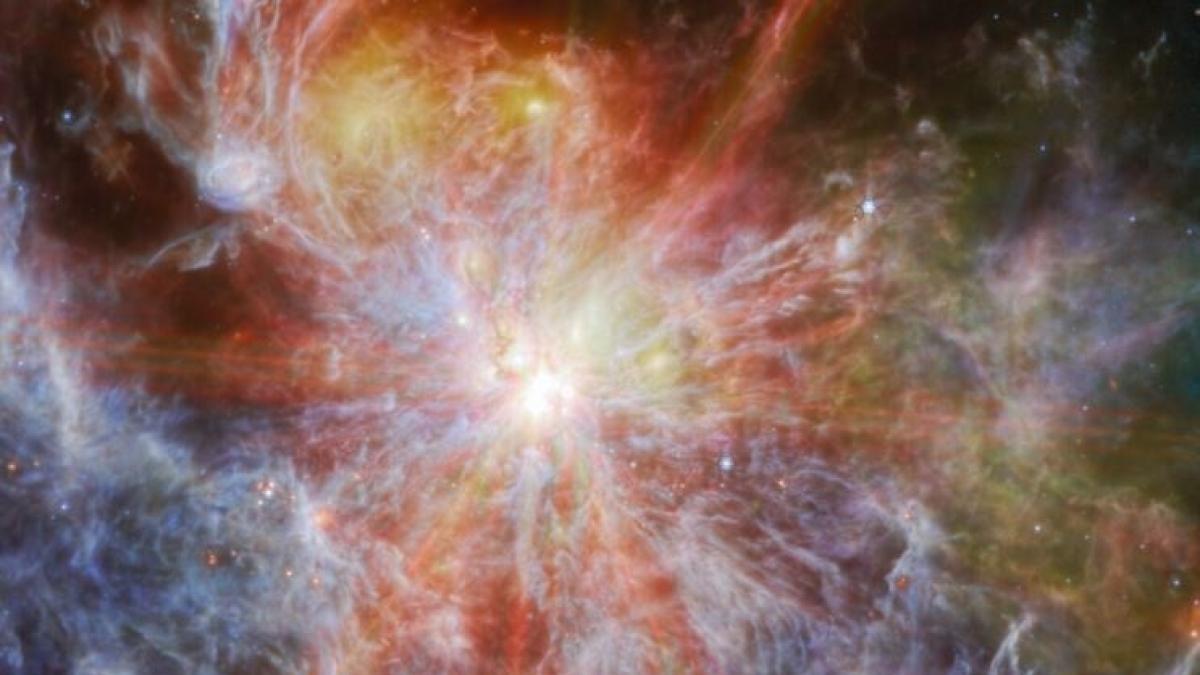This image from NASA, ESA and CSA's James Webb Space Telescope shows a huge region of bright gas and plasma in the Large Magellanic Cloud (LMC), a satellite galaxy of our own Milky Way.
This nebula, known as N79, is a region of ionized interstellar atomic hydrogen, captured here by Webb's mid-infrared instrument (MIRI).
N79 is a massive star-forming complex extending about 1,630 light-years in the generally unexplored southwestern region of the LMC. N79 is often considered a smaller version of 30 Doradus (also known as the Tarantula Nebula), one of Webb's recent targets. Research suggests that N79 has a star formation efficiency exceeding 30 Dorados by a factor of two over the past 500,000 years.
This image focuses on one of the three giant molecular cloud complexes, called N79 South (S1 for short). The distinctive “starburst” pattern surrounding this bright object is a series of diffraction peaks. All telescopes that use a mirror to collect light, as Webb does, have this type of artifact that arises from the telescope's design, ESA said in a statement.
In Webb's case, the six largest peaks of the starburst appear due to the hexagonal symmetry of the eighteen segments of Webb's primary mirror. Such patterns are only noticeable around compact and very bright objects, where all the light comes from the same place. Most galaxies, although they appear very small to our eyes, are much darker and more diffuse than a single star, and therefore do not show this pattern.
In the longer wavelengths of light captured by MIRI, Webb's view of N79 shows bright gas and dust in the region. This is because mid-infrared light is able to reveal what is happening deep within the clouds (whereas shorter wavelengths of light would be absorbed or scattered by the nebula's dust grains). Some still-contained protostars are also visible in this field.
Star-forming regions like these are of interest to astronomers because their chemical composition is similar to that of giant star-forming regions observed when the universe was only a few billion years old and star formation was at its peak. The star-forming regions in our Milky Way Galaxy do not produce stars at the same rapid rate as N79 and have a different chemical composition. Webb now gives astronomers the opportunity to compare and contrast observations of star formation in N79 with deep telescope observations of distant galaxies in the early universe.
These N79 observations are part of Webb's program that studies the evolution of circumstellar disks and star-forming envelopes over a wide range of masses and at different evolutionary stages. Webb's sensitivity will allow scientists to detect planet-forming dust disks for the first time around stars with a mass similar to our Sun at the LMC distance.

“Proud web fanatic. Subtly charming twitter geek. Reader. Internet trailblazer. Music buff.”

:quality(85)/cloudfront-us-east-1.images.arcpublishing.com/infobae/TEQF6EONZRFGLLLDIDD4L2O4EE.jpg)

:quality(75)/cloudfront-us-east-1.images.arcpublishing.com/elcomercio/XU32LRAEZFDDPNVHLFU3CKVBYY.jpg)



More Stories
How to create 3D videos with my iPhone, it will be very useful even for your business
NASA discovers an anomaly in the Earth’s magnetic field that could have serious consequences for humans
Can the Earth be divided into two parts?